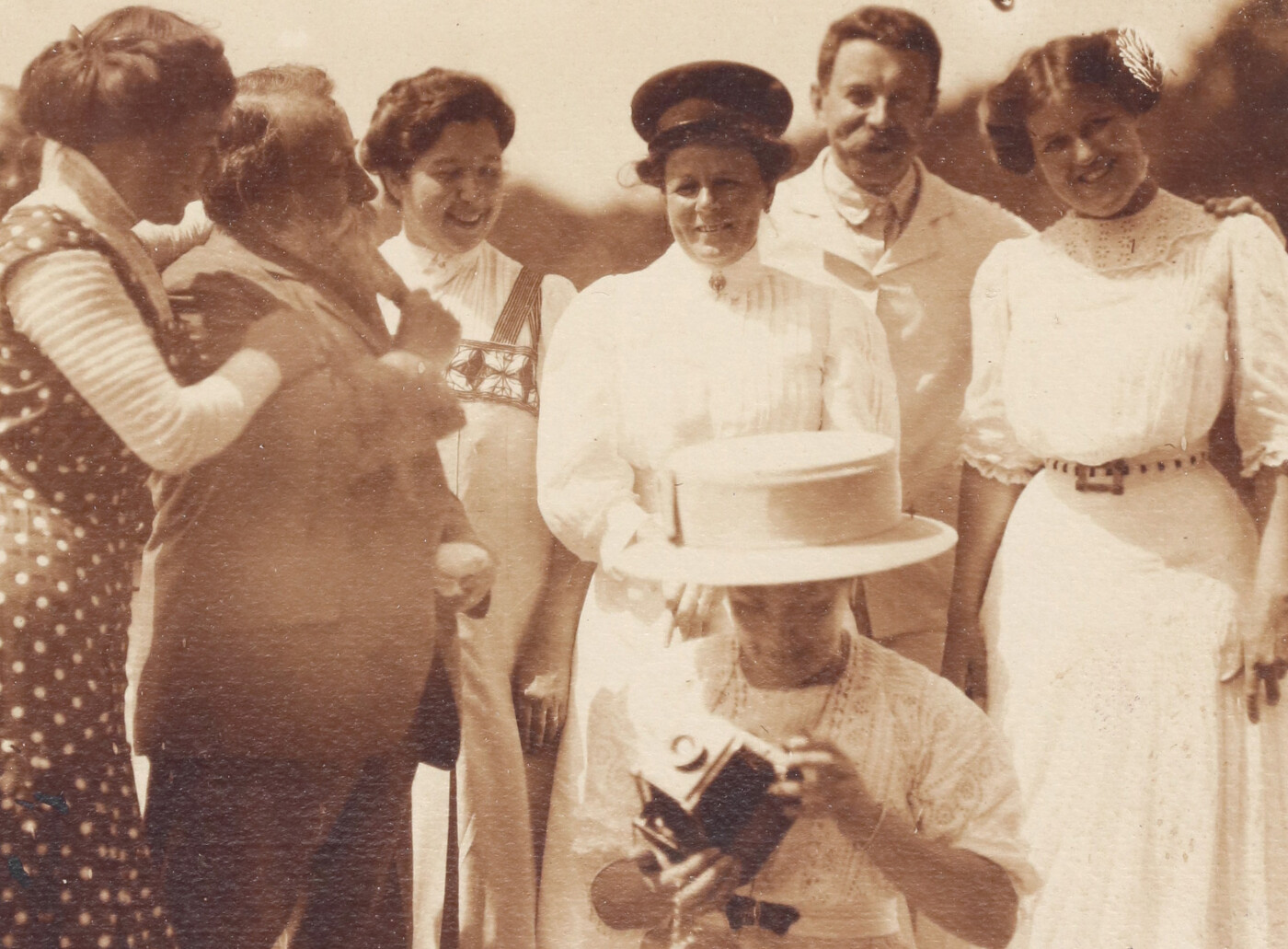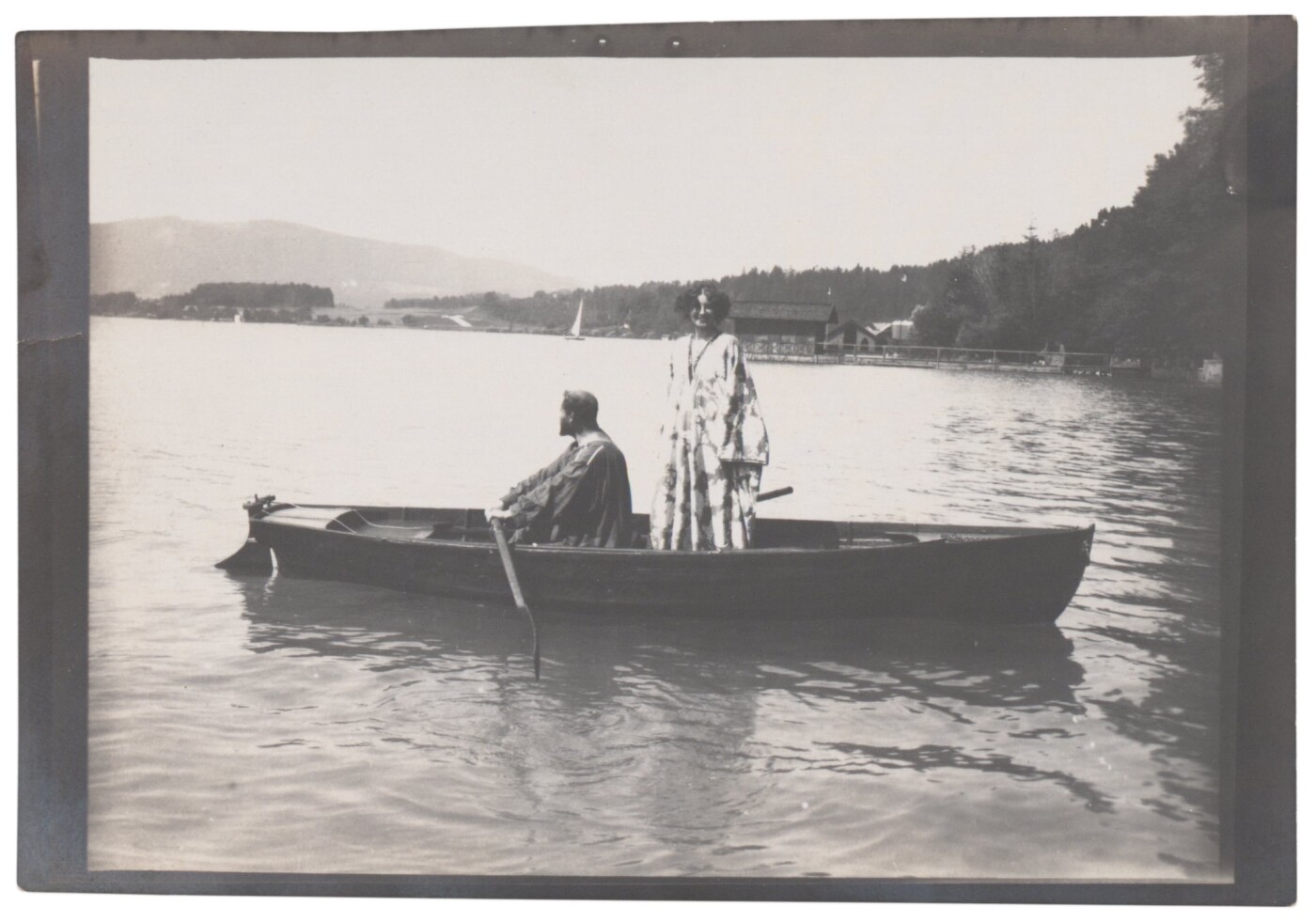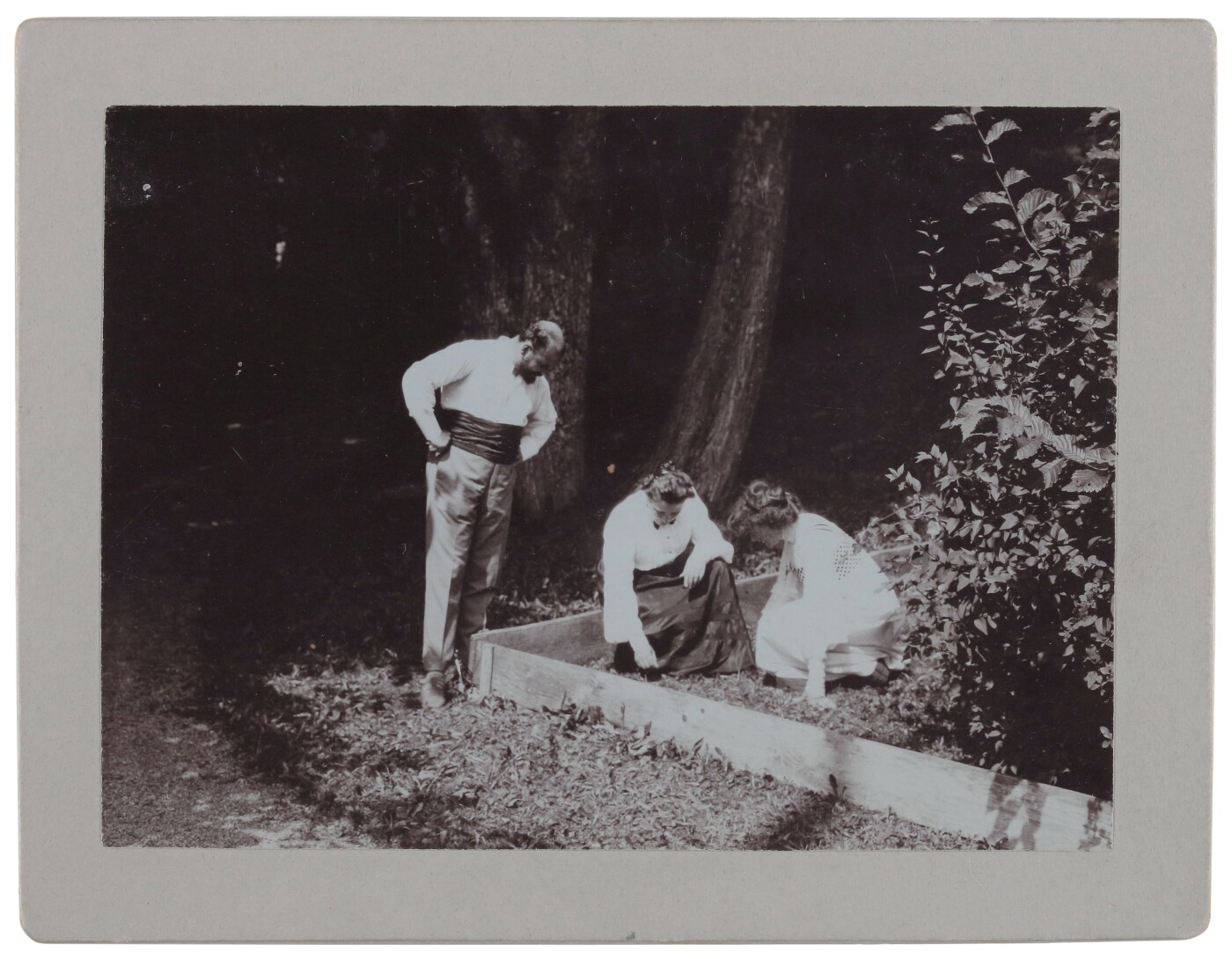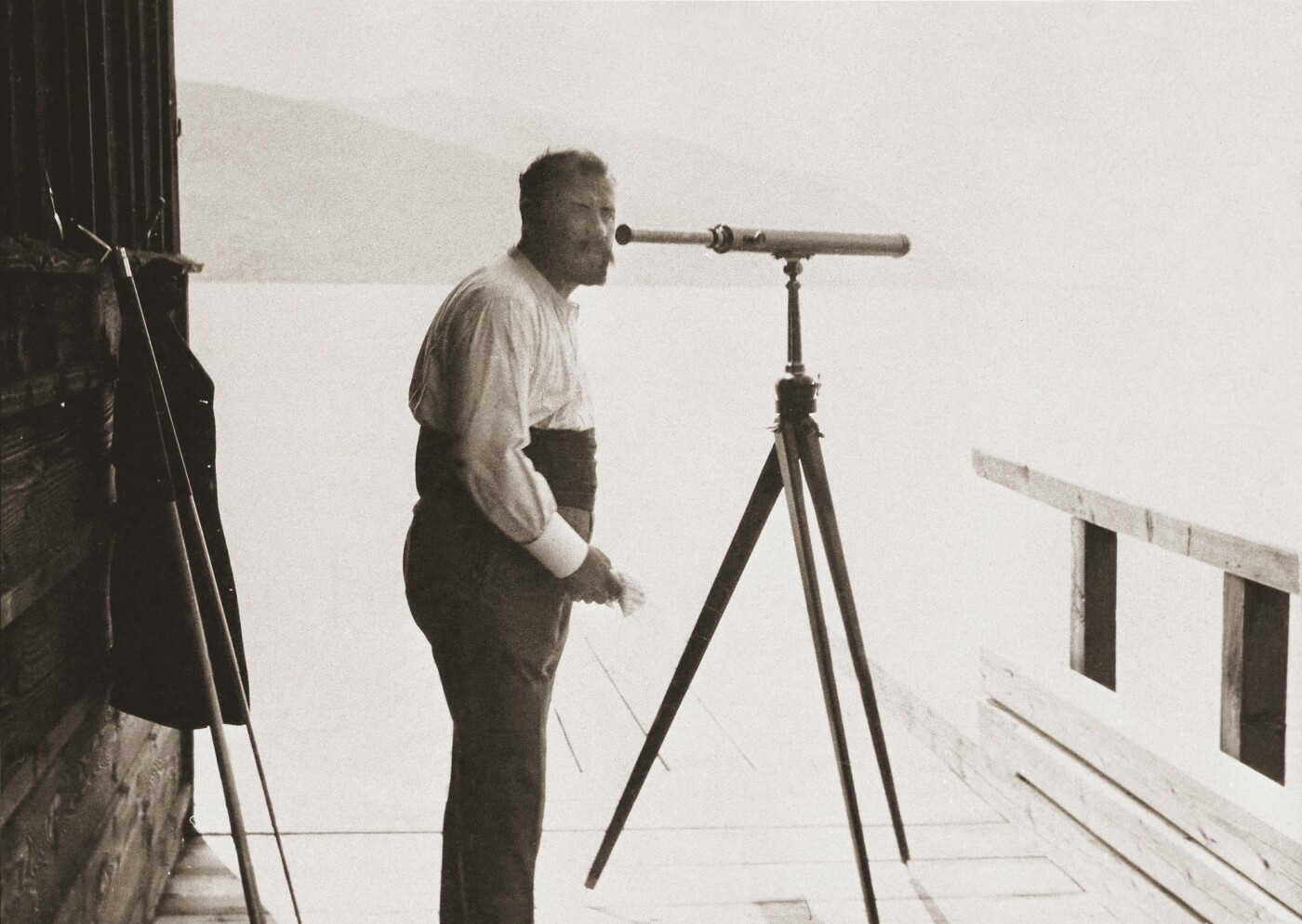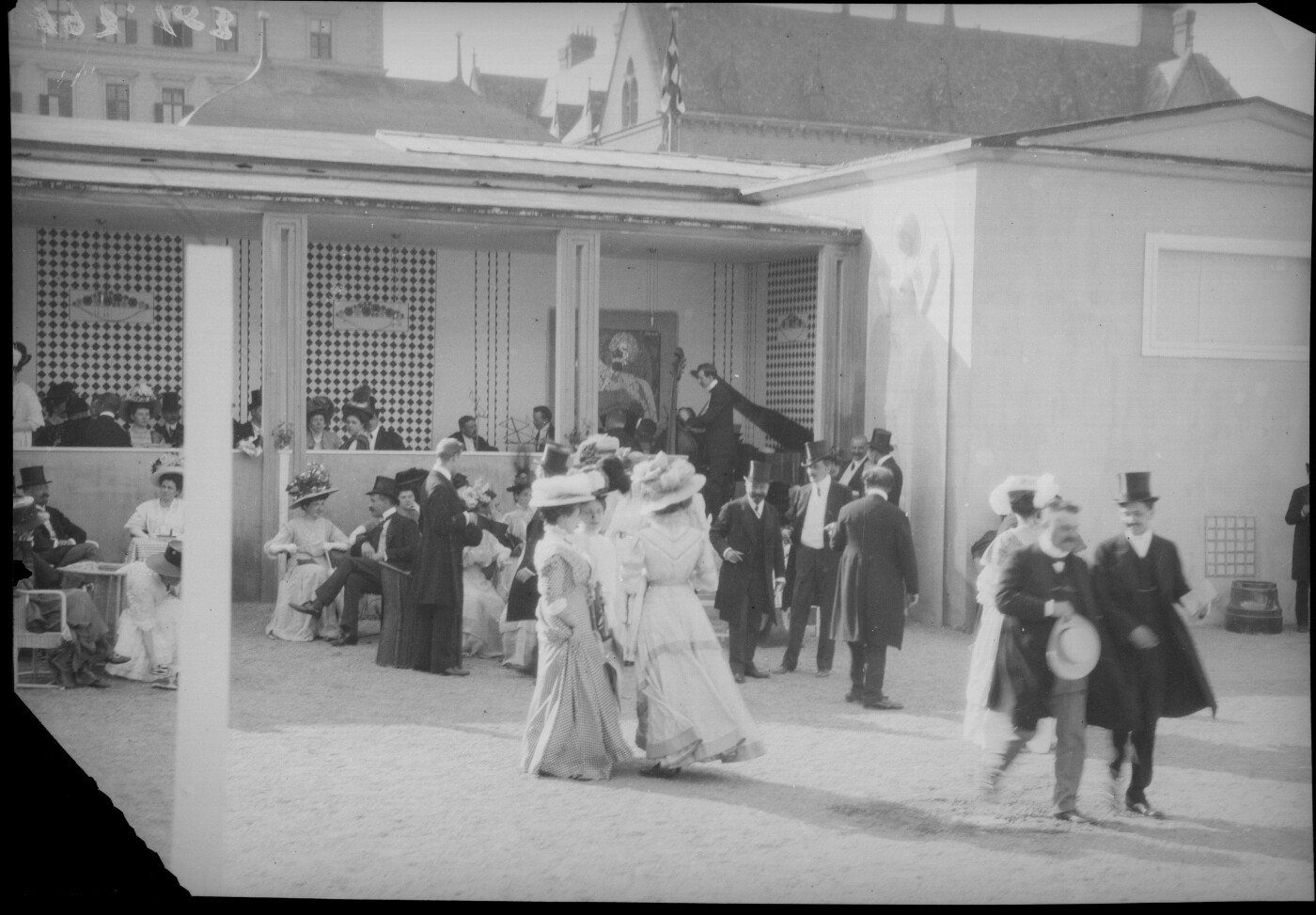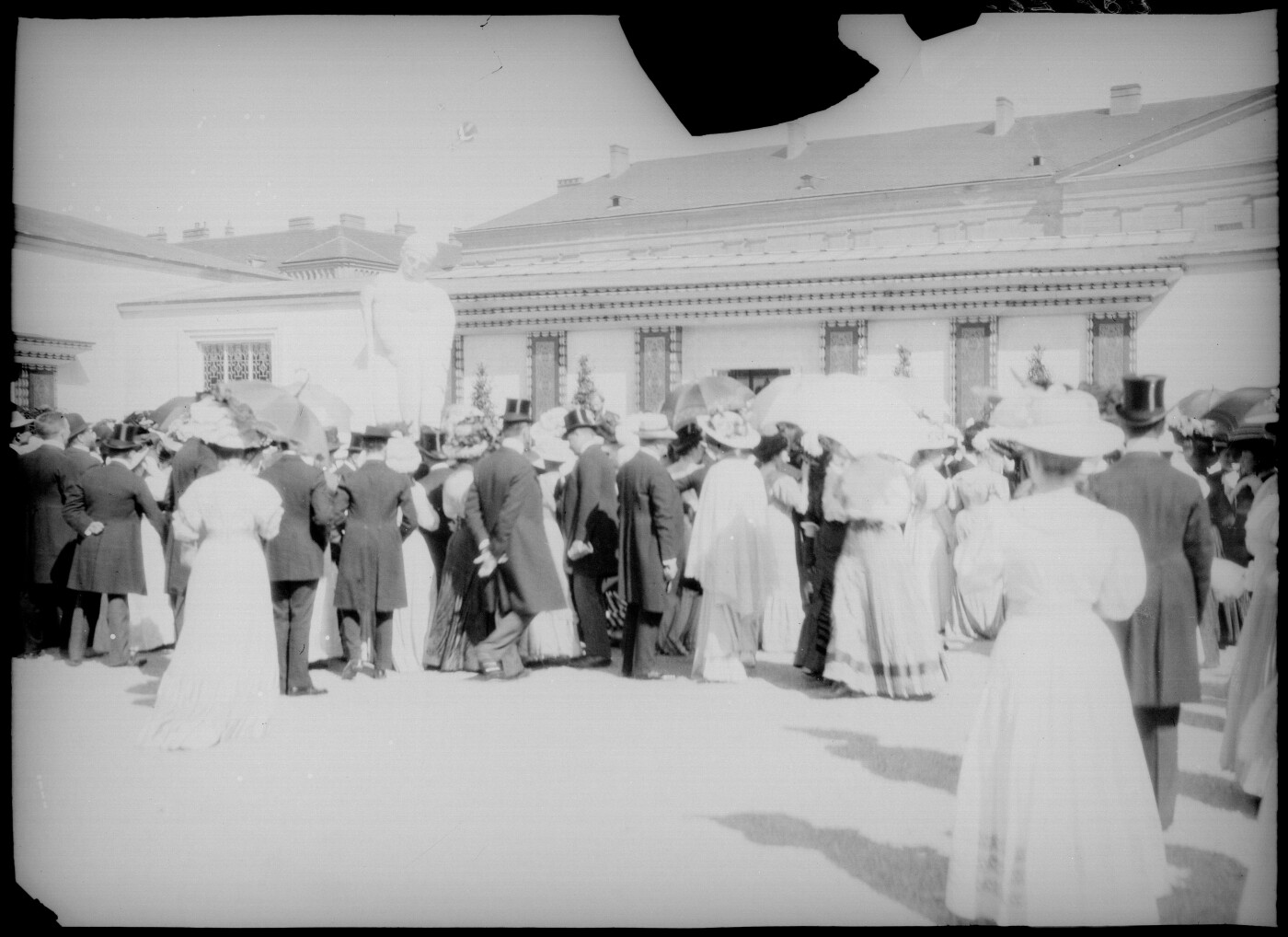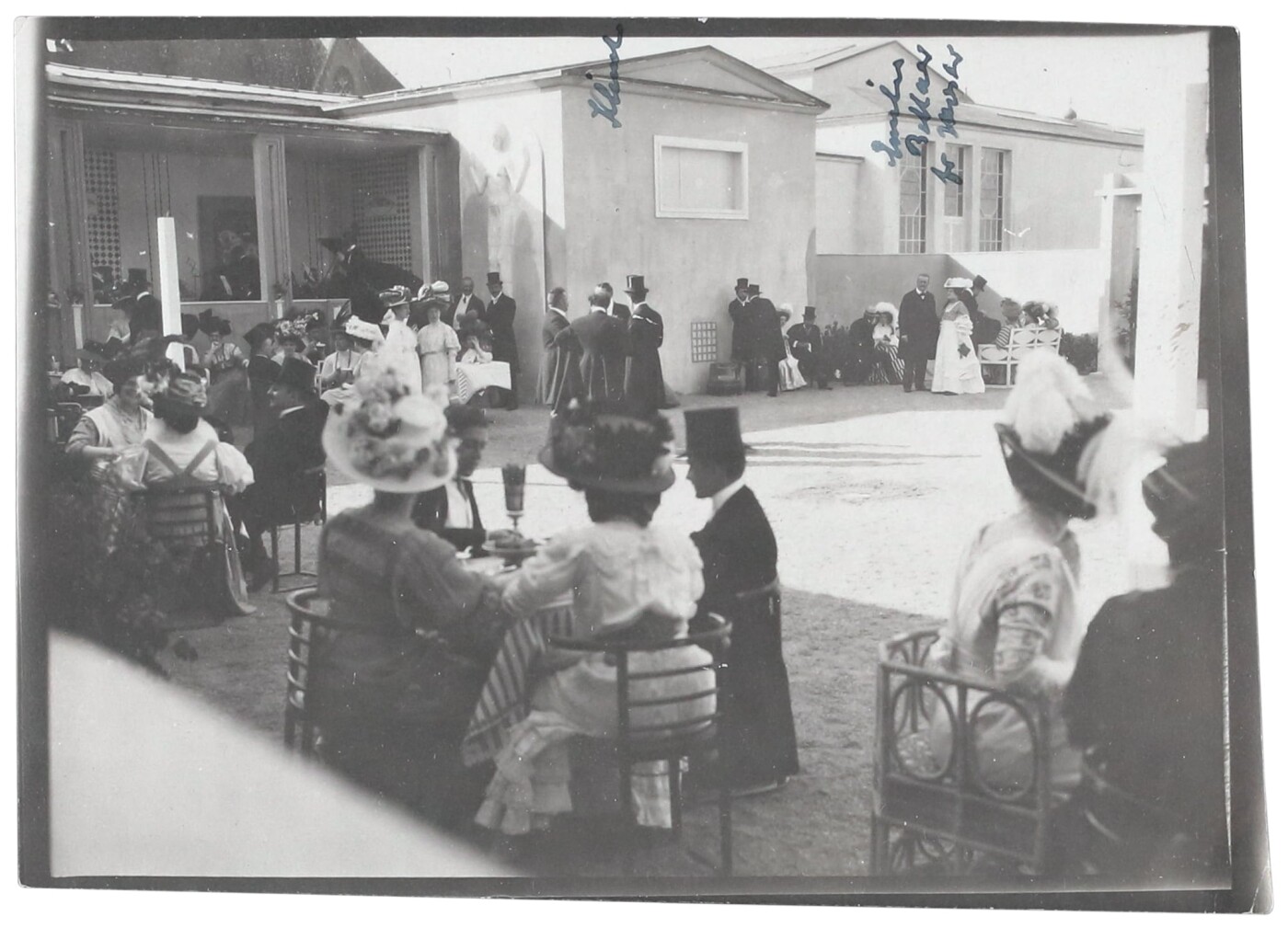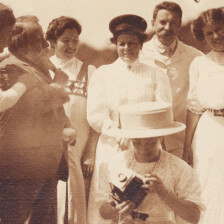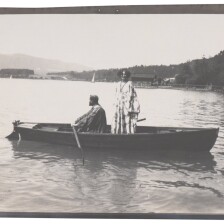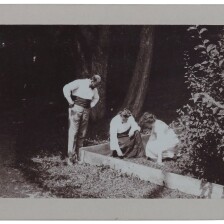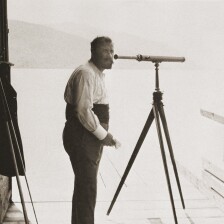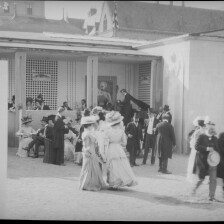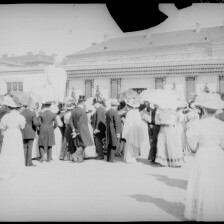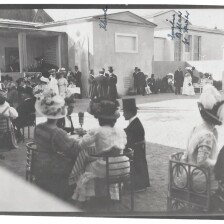Emma Bacher-Teschner
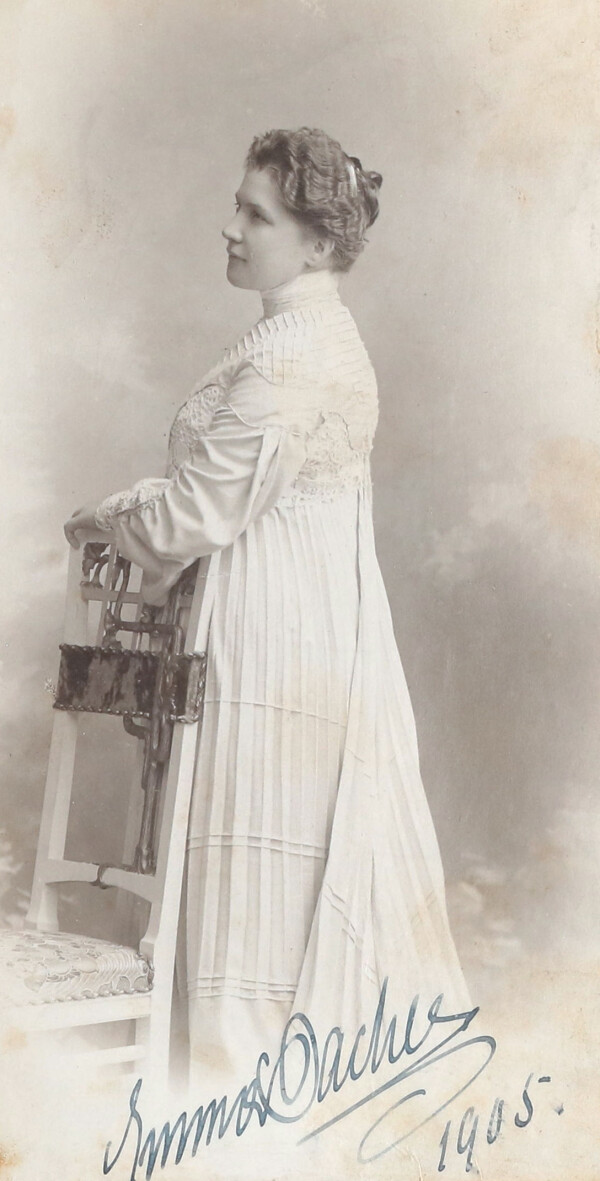
Emma Bacher, 1905, in: Rudolf Schuh: Nr. 7. "Aus meinem Leben" von Dr. Rudolf Schuh in Seewalchen am Attersee - 1908 bis 1910, in: Autobiografie Dr. Rudolf Schuh, S. 2301-2446.
© Klimt Foundation, Vienna
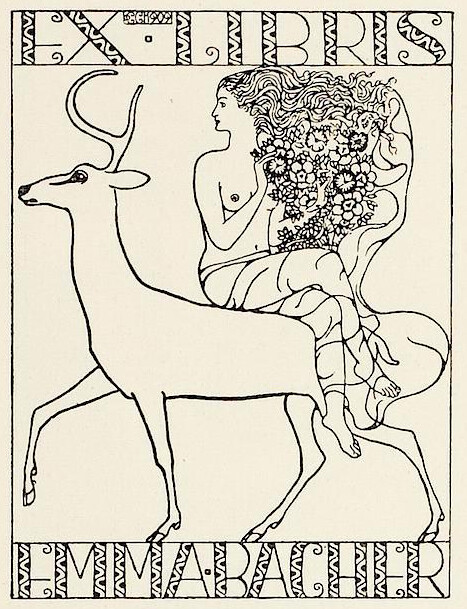
Carl Otto Czeschka: Ex-libris for Emma Bacher, 1909, in: Die Graphischen Künste, 37. Jg., Heft 1 (1914).
© Heidelberg University Library
Emma Paulick was born on 27 November 1867 in Vienna, the youngest child of Imperial-Royal court carpenter Friedrich Georg Paulick and Therese Paulick sen., née Groner. Together with her older sisters Therese jun. and Maria, and her brother Friedrich jun., Emma spent her childhood in Vienna. During the summer months, the family holidayed in Seewalchen on the Attersee, where her father had built a summer residence in 1870, known as Villa Paulick.
The Paulick, Bacher, Klimt and Flöge Families
At their villa on the Attersee, the family received numerous guests, including the Bacher family. The guestbook of Villa Paulick documents the family’s first visit in 1892. It was likely during that visit that Emma met the 26-year-old gold and silver manufacturer Paul Bacher, whom she went on to marry in 1894. Via Paul, she met his good friend and fencing partner Gustav Klimt. Seeing as Klimt – as well as the Paulick family – would regularly summer on the Attersee together with the Flöge family, the four families entered into close contact. In 1906, Emma’s sister Therese married Hermann Flöge, Emilie Flöge’s brother. Numerous picture postcards and photographs show the four families in the garden of Villa Paulick and during excursions and boat rides.
Management of Galerie Miethke and Amateur Photography
In November 1904, Paul Bacher bought the renowned art gallery H. O. Miethke on Dorotheergasse, and appointed Carl Moll as artistic director. Bacher and Moll turned the art dealership into one of the most eminent galleries of modern art. They represented the greatest artists of the Secession, including Gustav Klimt. When Paul Bacher died in 1907, his widow Emma Bacher became the gallery’s new proprietor. Thus, she was one of only a handful of women to run their own business and actively shape the male-dominated art scene at the time. In 1908, Galerie Miethke made essential contributions to the organization of the exhibition “Kunstschau Wien,” designed by the Secession’s then president Gustav Klimt.
Through her work, Emma established contacts, and sometimes also friendships, with numerous contemporary artists. While she did not collect art herself, she owned several bookplates by eminent artists, including Oskar Kokoschka, Leopold Drexler, Mileva Roller, Carl Otto Czeschka and Richard Teschner. In 1906, she had her portrait taken by Madame d’Ora, who, as one of the best photographers in Vienna around 1900, also captured Gustav Klimt and Emilie Flöge on camera.
Emma Bacher herself took a keen interest in amateur photography. In 1908, she documented the opening of the “Kunstschau Wien” with her photographs. Equipped with a small camera, she captured the visitors – among them family members – on the exhibition grounds in a series of snapshots. We further owe several private photographs taken during the summer sojourns on the Attersee to her. Boasting the “snapshot format,” a format typical for amateur photographers measuring approx. 12 x 9 cm, the pictures show Klimt and Emilie Flöge with friends and family members during boat rides and in the environs of Villa Paulick.
Emma Bacher-Teschner as an Amateur Photographer
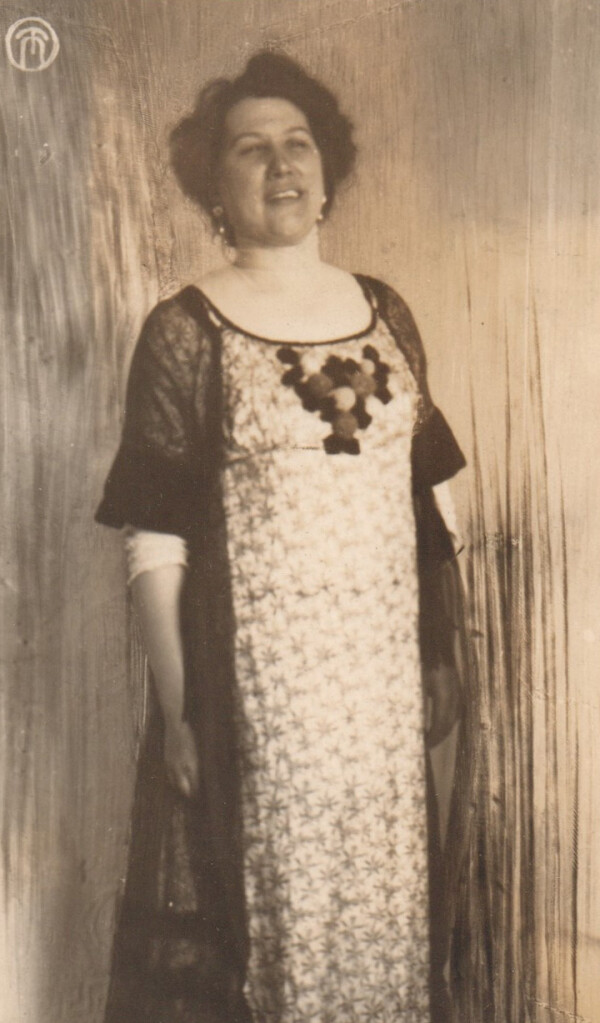
Emma Teschner, photographed by Richard Teschner, probably after 1911
© Klimt Foundation, Vienna
Private and Professional Changes
After her husband’s early death, Emma increasingly spent time with the family of her sister Therese, who lived in the same Viennese apartment building. Therese had become a mother in 1907, and Emma thrived in her role as aunt, nurturing an intimate relationship with her nice Gertrude, lovingly called Trudl.
The Paulick, Flöge and Klimt families continued to spend their summers on the Attersee. Time and again, artist friends were invited to stay at Villa Paulick, among them the Universalkünstler [universal artist] Richard Teschner, whom Emma Bacher likely already knew through her contacts and her work for Galerie Miethke. Emma and Richard Teschner embarked on a relationship. In 1909, the couple celebrated their engagement on the Attersee together with friends and family members, and married in 1911. Emma took her husband’s name, and the couple moved into an apartment at Gersthofer Straße 105.
Emma’s marriage to Klimt’s friend and colleague intensified the friendship between her and Klimt. Numerous extant picture postcards reveal that Klimt and Emma engaged in an animated correspondence. On numerous occasions, the artist thanked Emma for her food provisions for travels or for her Christmas cookies: “Thank you most kindly for the sweet travel ‘cookies’,” and gladly accepted her invitations:
“We [NB: Gustav Klimt and Emilie Flöge] thank you kindly for your invitation and delightedly accept.”
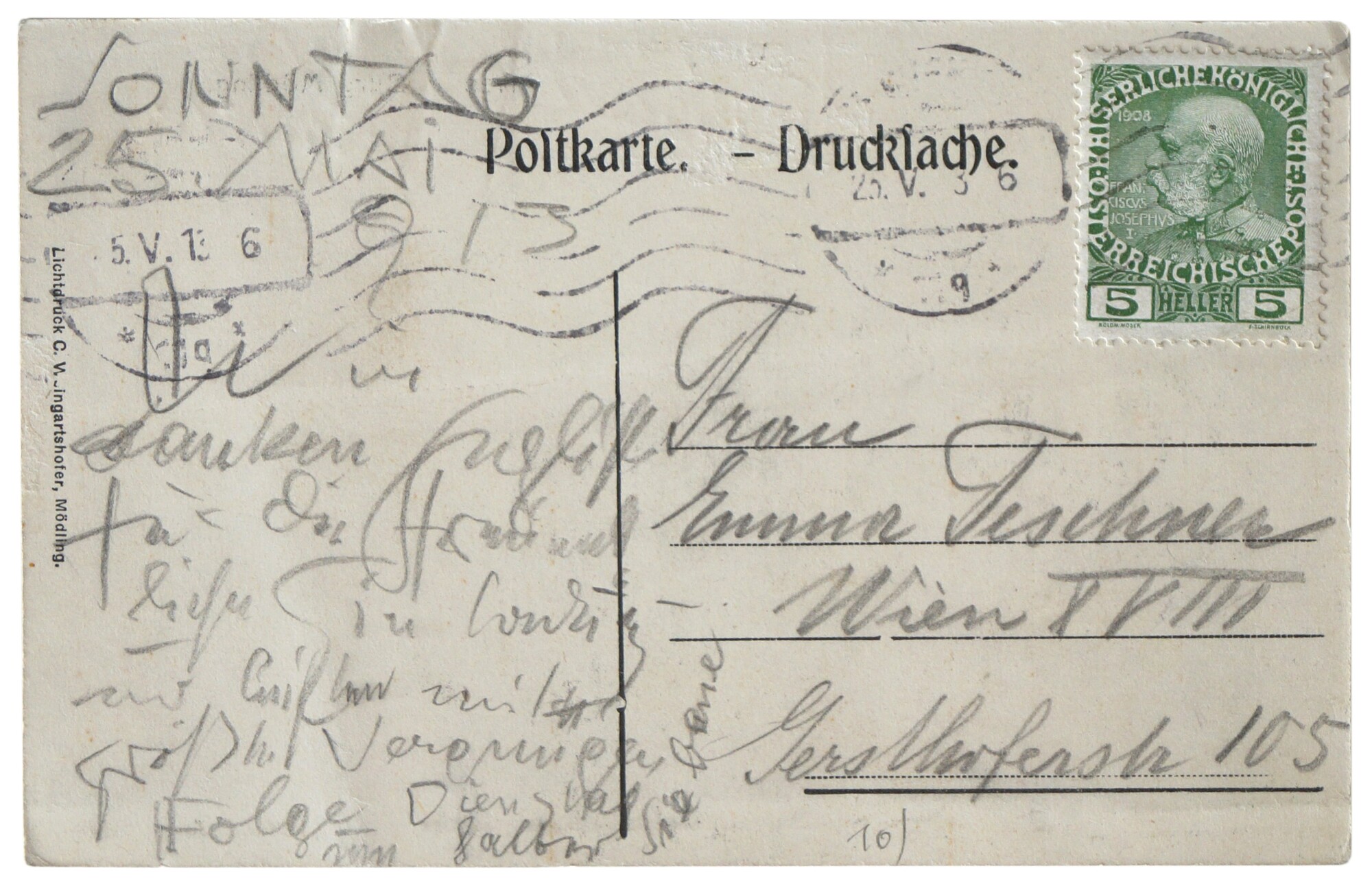
Gustav Klimt: Picture postcard from Gustav Klimt to Emma Bacher-Teschner in Vienna, co-signed by Emilie Flöge, 05/25/1913, Klimt Foundation
© Klimt Foundation, Vienna
In 1917, Emma Teschner sold Galerie Miethke to her long-standing assistant Dr. Hugo Haberfeld and retired from the art trade. Emma’s second husband Richard Teschner died in 1948. Owing to her meagre honorary pension, she was forced to sell her husband’s valuable estate piece by piece. Seeing as both marriages were childless, she could not hope for any financial support. Emma Bacher died on 25 June 1953 in Vienna. She was laid to rest at Vienna Central Cemetery, where her two husbands Paul Bacher and Richard Teschner had also been buried.
Literature and sources
- Tobias G. Natter (Hg.): Die Galerie Miethke. Eine Kunsthandlung im Zentrum der Moderne, Ausst.-Kat., Jewish Museum Vienna (Vienna), 19.11.2003–08.02.2004, Vienna 2003.
- Agnes Husslein-Arco, Alfred Weidinger (Hg.): Klimt & Emilie Flöge. Fotografien, Vienna 2012, S. 231.
- Markus Kristan: Kunstschau Wien 1908, Vienna 2016, S. 22-23.
- Meldezettel, Wiener Stadt- und Landesarchiv, Akt 2.5.1.4.K11.Teschner Richard. 22.3.1879. www.wien.gv.at/actaproweb2/benutzung/archive.xhtml (04/28/2020).
- Wien Geschichte Wiki. Friedrich Georg Paulick. www.geschichtewiki.wien.gv.at/Friedrich_Georg_Paulick (04/28/2020).
- Heinrich R. Scheffler: Richard Teschner. Die Wiener Werkstätte und ihre Exlibris Künstler. www.exlibris-austria.at/03_artikel/03_01_wrwerk.html (04/07/2020).
- Eintrag von Gustav Klimt und der Familie Flöge im Gästebuch der Villa Paulick in Seewalchen am Attersee (08/10/1900). LGM 14, .
- Gästebuch der Villa Paulick. 1881–1947, .
- Ansichtskarte von Gustav Klimt in Rom an Emma Bacher in Wien, DLSTPW16 (28.03.1911), .
- Ansichtskarte von Gustav Klimt an Emma Bacher-Teschner in Wien, mitunterschrieben von Emilie Flöge (25.05.1913). S37.
- Korrespondenzkarte von Richard Teschner am Attersee an Karl Teschner in Wien, mitunterschrieben von Gustav Klimt, Emilie, Pauline und Barbara Flöge, Emma Bacher, Helene Klimt jun. und Helene Klimt sen., LGM 31/15 (23.08.1910), .
- Neues Österreich, 17.10.1950, S. 4.
- Brief von Eugenia „Mäda“ Primavesi sen. in Olmütz an Anton Hanak (26.01.1912). Mappe 17.
- Neues Wiener Tagblatt, 26.02.1912, S. 17.
- Wiener Zeitung, 23.10.1907, S. 21.
- Rudolf Schuh: Nr. 7. "Aus meinem Leben" von Dr. Rudolf Schuh in Seewalchen am Attersee - 1908 bis 1910, in: Autobiografie Dr. Rudolf Schuh, S. 2301-2446.
- Heinrich R. Scheffer: Die Wiener Werkstätte und ihre Exlibris Künstler. www.exlibris-austria.at/03_artikel/03_01_wrwerk.html (11/09/2021).
- Uwe Schögl: Emilie Flöge in zeitgenössischen Fotografien, in: Sandra Tretter, Peter Weinhäupl (Hg.): Gustav Klimt. Emilie Flöge. Reform der Mode. Inspiration der Kunst, Vienna 2016, S. 43-55.


